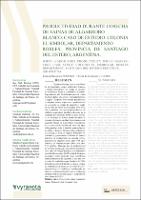Productividad durante cosecha de vainas de Algarrobo Blanco. Caso de estudio: Colonia El Simbolar, Departamento Robles, Provincia de Santiago del Estero, Argentina
White Carob pods productivity while harvesting. Case study: Colonia el Simbolar, Robles Department, Santiago del Estero Province, Argentina
Date
2020-12-11Author
García, Jorge Martín
Cardona, Gabriela Gladis
Sánchez Ugalde, Rocío
Metadata
Show full item recordAbstract
El género Prosopis spp es considerado un importante recurso alimenticio humano y animal aportado por sus vainas en regiones de condiciones áridas y semiáridas del mundo. Argentina ha sido identificada como el centro de diversidad de este género, particularmente en la región Chaqueña. Este trabajo pretende hacer algunos aportes respecto a la productividad en la cosecha de vainas de algarrobo y analizar la venta de frutos en el mercado local. Para ello se analizan cosechas en plantaciones y en unidades económicas familiares ubicadas en la localidad de Colonia El Simbolar de la provincia de Santiago del Estero, localidad donde se concentra la mayor cantidad de plantaciones de algarrobo blanco en la provincia. Actualmente en la actividad de cosecha del fruto del algarrobo participa toda la familia, principalmente los niños y mujeres. El pago a los recolectores es a destajo, es decir, se paga por kilogramo recolectado y generalmente se lo hace de manera informal. La productividad de cosecha en bosques puros de algarrobo oscila entre 7-16 kg/h/hombre y el rendimiento por árbol varía entre 7-11 kg/árbol. Mientras que la productividad de cosecha en unidades económicas familiares varía ente 10-18 kg/h/hombre y el rendimiento por árbol fluctúa entre 11-15 kg/árbol. Teniendo en cuenta el aporte medio de vainas por árbol en plantaciones puras de algarrobo, y con una proyección de rendimiento por hectárea del 50% de la densidad total de árboles, se puede estimar un rendimiento de frutos en un valor de 2.777 kg/ha (8,9 kg x 312 árboles). Considerando los ingresos y egresos en la actividad, se estima una ganancia neta por hectárea para el acopiador de estos frutos de $5.554. The genus Prosopis spp is considered an important human and animal food resource provided by its pods in arid and semi- arid regions in the world. Argentina has been identified as the center of diversity of this genre, particularly in the Chaqueña region. This work aims to make some contributions in productivity terms of the carob pod harvest and analyze the sale of fruits in the local market. For this, crops are analyzed in plantations and in family economic units located in the town of Colonia El Simbolar in the province of Santiago del Estero, town where most of the white carob plantations are concentrated. Currently, by harvesting the carob tree fruit, the whole family takes part, mainly children and women. Payment for collectors is piece-rate, that is, it is paid per kilogram collected and it is generally done informally. Harvest productivity in pure carob forests ranges from 7-16 kg / h / man and the yield per tree varies between 7-11 kg / tree. However, the harvest productivity in family economic units varies between 10-18 kg / h / man and the yield per tree fluctuates between 11-15 kg / tree. Taking into account the average contribution of pods per tree in pure carob plantations, and with a projection of yield per hectare of 50% of the total density of trees, a fruit yield of 2777 kg / ha can be estimated (8.9 kg x 312 trees). Considering the income and expenses in the activity, it is estimated a net profit per hectare of $ 5.554. for the stockholder of these fruits.
Collections
- Revista Yvyraretá [360]
The following license files are associated with this item:



